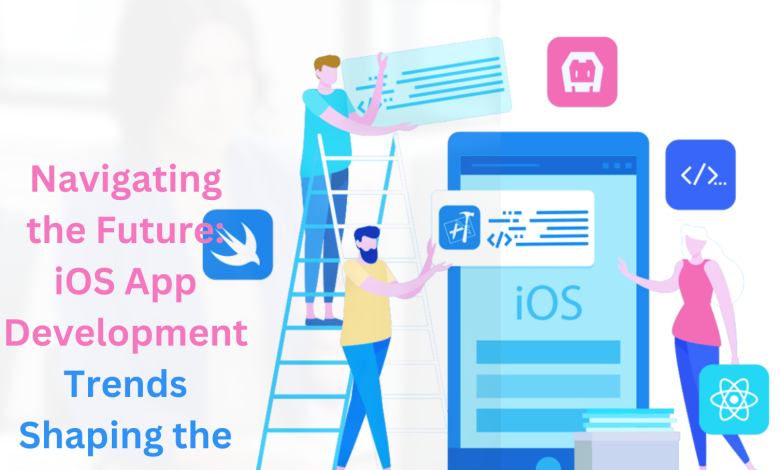Navigating the Future: iOS App Development Trends Shaping the future

Introduction
Mobile apps have revolutionized how we engage with technology, and iPhone apps are prominent in this revolution. Whether you’re an aspiring app creator aiming to introduce your innovation to the iOS platform or a business owner striving to enrich the user experience, this comprehensive guide is your compass. We’ll walk you through the process of launching an app on iOS systems and introduce you to a distinguished iOS app development company that can help amplify your app’s potential.
Understanding iOS App Development: Simplified
Before you launch your app, it’s essential to grasp the basics of iOS systems and their distinct attributes. iOS offers a consistent and user-friendly experience across various devices, making it a popular choice among app users. Get acquainted with the Swift programming language, Apple’s Human Interface Guidelines, and the App Store Review Guidelines to ensure your app meets Apple’s requirements.
Choosing the Right App Idea:
Creating a successful iPhone app starts with a brilliant idea that solves a real-world problem or fulfills a need. As you embark on the journey of app development, consider the following steps to ensure that you’re choosing the right app idea that has the potential to resonate with users and stand out in the market.
Finding a Gap in the Market:
One of the most effective ways to develop an app idea is to identify gaps in the market. Look at existing apps within your niche and analyze if a particular area is underserved or lacks innovation. Ask yourself, “What can I offer that no one else provides?” Finding a niche or addressing an overlooked aspect of an existing market can give your app a competitive edge.
Consider researching user reviews of similar apps to understand what users like and dislike. This can provide insights into what improvements or features users are seeking. Remember, innovation doesn’t always mean creating something entirely new; it can also involve improving existing solutions.
Identifying User Pain Points: A successful app addresses a specific pain point or challenge users face daily. Please pay close attention to the pain points that potential users express, whether it’s through online forums, social media, or surveys. These pain points range from simple inconveniences to more complex problems requiring a sophisticated solution.
Think about your target audience and their needs. Are there tasks they find tedious or time-consuming? Are there frustrations they encounter regularly? Identifying these pain points will guide your app idea and ensure that your app provides genuine value to users.
Validating Your App Idea:
Once you have a potential app idea in mind, validating it before investing significant time and resources is crucial. Validation helps confirm whether there’s a demand for your app and whether users will engage with it. Here are some ways to validate your app idea:
- Surveys and Questionnaires: Create surveys to gather feedback from your target audience. Ask questions about their preferences, needs, and whether they would be interested in using an app that addresses the problem you’re aiming to solve.
- Minimum Viable Product (MVP): Develop a simplified version of your app with essential features and test it with a small group of users. Their feedback will provide insights into whether your app meets their expectations.
- Landing Page: Create a landing page that showcases your app idea and its benefits. Use this page to collect email addresses of interested users. If you receive significant sign-ups, it’s a positive sign of interest in your app.
- Competitor Analysis: Analyze the competition to see if similar apps exist. If there are, evaluate their strengths and weaknesses and consider how your app can offer something unique.
- Social Media Engagement: Share your app idea on social media platforms and gauge the response. Pay attention to likes, shares, and comments to determine user interest.
The Step-by-Step Launch Process:
- Idea Generation: Identify the issue your app addresses and define your target user group. Study existing apps to carve out a unique space for your creation.
- Design and Building: Develop wireframes and prototypes to map your app’s user interface and experience. Once satisfied, proceed with actual development using Swift or other preferred tools.
- Thorough Testing: Rigorous testing is your secret weapon to uncover and rectify bugs or glitches. Utilize platforms like TestFlight to collect feedback from beta testers and refine your app.
- You are preparing for the App Store: Craft captivating app icons, screenshots, and an enticing description. Mastering App Store Optimization (ASO) is your ticket to being easily discoverable.
- Submission to the App Store: Adhere to the guidelines set by App Store Connect as you submit your app. This involves setting up metadata, preparing for app reviews, and providing the necessary assets.
- The App Review Process: Apple’s review ensures app quality and security. Stay patient and address any feedback or recommendations from Apple’s review team.
- Launch Day: Once you receive the green light, set a launch date and promote your app through various channels. Leverage social media, collaborate with influencers, and harness your website to build anticipation.
Elevating User Experience with a Leading iOS App Development Partner:
Teaming up with a professional app development company in UK can significantly enhance your app’s user experience and overall success. Some experts stand out in the realm of iOS app development, ready to help you materialize your vision.
Services Offered by Elite iOS App Development Partners:
- Strategic Blueprinting: These experts collaborate closely with you to comprehend your app’s objectives and target audience, ensuring a well-defined development strategy.
- User-Centric Design: Design maestros create intuitive interfaces, seamless navigation, and visually captivating layouts, all contributing to an engaging user experience.
- Rock-Solid Development: Experienced developers employ cutting-edge tools and technologies to construct an app that’s high-performing and meets Apple’s stringent criteria.
- Thorough Testing and Quality Assurance: Rigorous testing across diverse devices guarantees your app functions seamlessly, offering users an extraordinary experience.
- Post-Launch Support: Accomplished iOS App Development Partners extend continuous support to tackle issues, implement updates, and incorporate user feedback for ongoing enhancements.
Conclusion:
The journey of launching an iPhone app is exhilarating, demanding meticulous planning, development, and promotion. By adhering to the steps outlined in this guide and enlisting the aid of an esteemed iOS app development company, you can elevate user experience, broaden your reach, and thrive in the dynamic world of mobile apps. Embrace the potency of iOS and craft an app that users adore and depend on.
Remember, the journey doesn’t cease once your app is launched. Consistently gather user insights, monitor app performance, and adapt to shifting trends to ensure your app remains relevant and valuable in the long haul.



